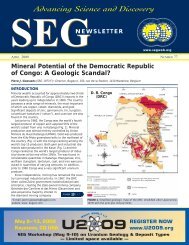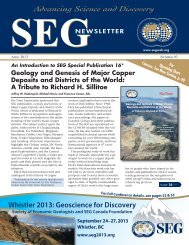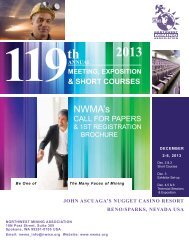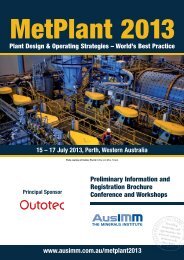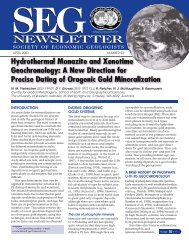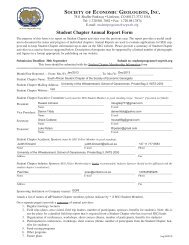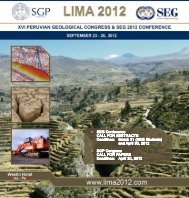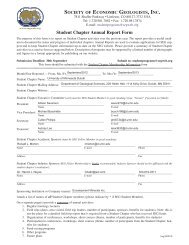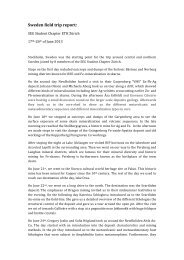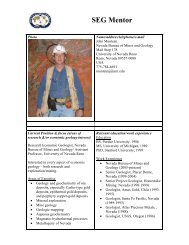SEG - Society of Economic Geologists
SEG - Society of Economic Geologists
SEG - Society of Economic Geologists
Create successful ePaper yourself
Turn your PDF publications into a flip-book with our unique Google optimized e-Paper software.
JULY 2012 • No 90 <strong>SEG</strong> NEWSLETTER 17<br />
Target cost<br />
It is difficult to estimate the cost <strong>of</strong> in -<br />
vestigating a target in advance. Limited<br />
low cost investigations may be enough to<br />
exclude a target. Otherwise, investigation<br />
will be a sequential process <strong>of</strong> increasing<br />
cost, possibly involving geochemistry,<br />
geophysics, rotary air blast and core drill -<br />
ing. Despite this, we shall assume for<br />
definiteness that the cost per target is<br />
proportional to its area; specifically, that<br />
the cost is $500K per km 2 , or $5K per<br />
hectare. Using the target areas shown in<br />
Table 1, the resulting cost estimates for<br />
the top 10 targets are shown in the cost<br />
column <strong>of</strong> Table 2.<br />
Target probability<br />
The concepts <strong>of</strong> Value and Cost are<br />
already enough for initial economic<br />
decisions. For example, in the case <strong>of</strong><br />
Target 1, the ROI (return on investment<br />
= expected gain divided by cost) exceeds<br />
400. It is natural, nonetheless, to ask for<br />
the probability <strong>of</strong> success for each target<br />
as a whole. The present study, however,<br />
does not directly model the probability<br />
that an extended area hosts a deposit;<br />
rather, it models the probability that a<br />
given location is within the footprint <strong>of</strong><br />
a mineable economic deposit. All the<br />
same, the peak probability over the target<br />
area is a lower bound on the probability<br />
<strong>of</strong> success for the target as a whole;<br />
so that this is shown in the probability<br />
column <strong>of</strong> Table 2, on the understanding<br />
that it may be an underestimate. For<br />
example, there is at least a 20% chance<br />
that the highest ranked target hosts an<br />
economic deposit.<br />
Multiple targets<br />
The rows <strong>of</strong> Table 2 relate to the risks<br />
and rewards for individual targets. But<br />
clearly an exploration strategy that<br />
tested multiple targets, consecutively or<br />
concurrently, would improve the overall<br />
chance <strong>of</strong> a discovery. For example,<br />
if the top 10 targets are tested, the<br />
probability <strong>of</strong> making at least one discovery<br />
is at least 70%; for at least two<br />
discoveries, it is at least 32%.<br />
As the totals in Table 2 show, the budget<br />
needed to investigate the top 10 targets<br />
is a little over $6.2M. The expected<br />
gain—that is to say, the sum <strong>of</strong> possible<br />
rewards multiplied by their probabilities<br />
—is $1.6 billion. The return on investment<br />
for a program that follows up just<br />
the top 10 targets is therefore greater<br />
than 250.<br />
<strong>SEG</strong><br />
www.segweb.org<br />
CONCLUSIONS<br />
As Enders and Saunders (2011) have<br />
pointed out, a new approach to exploration<br />
is needed to <strong>of</strong>fset the falling discovery<br />
rate. We believe that one way to<br />
address this problem is to put more effort<br />
into the targeting process. The probability<br />
<strong>of</strong> making a discovery is the product<br />
<strong>of</strong> the probability p that a deposit exists<br />
and the probability q <strong>of</strong> finding it, assuming<br />
that it exists. Much effort in recent<br />
years has gone into improving q, resulting<br />
in great strides in modern explora -<br />
tion tools. However, there has been scant<br />
change in the targeting process, which<br />
can strongly impact probability p.<br />
In this article, we have proposed a<br />
data mining process which takes advantage<br />
<strong>of</strong> all the available data in a given<br />
area. A critical aspect <strong>of</strong> this approach is<br />
its proper and complete representation<br />
<strong>of</strong> the data. The statistical process can<br />
then integrate hundreds <strong>of</strong> possibly<br />
interdependent data layers, with each<br />
making its own appropriate statistically<br />
determined contribution. The outcome<br />
is a sharply focused target map that<br />
assigns numerical probabilities <strong>of</strong> making<br />
an economic discovery. This map can<br />
then be used for systematically ranking<br />
and rating targets and planning a costeffective<br />
followup program.<br />
This approach will naturally work best<br />
in mature districts like the EGN where<br />
there is a wealth <strong>of</strong> known deposits and<br />
multidisciplinary data. In other parts <strong>of</strong><br />
the world where there may be less data,<br />
the data mining approach will still provide<br />
benefits although it may not produce<br />
such sharply focused targets. For -<br />
tunately, there is now an encouraging<br />
trend to produce more such comprehensive<br />
data sets as governments globally<br />
around the world increasingly<br />
appreciate that this is the best way to<br />
stimulate exploration and mineral<br />
development in their own countries.<br />
ACKNOWLEDGMENTS<br />
The authors would like to thank Greg<br />
Hall and Noel White for their helpful<br />
and critical readings <strong>of</strong> earlier drafts <strong>of</strong><br />
this article.<br />
REFERENCES<br />
Barnett, C.T., and Williams, P.M., 2006, Min -<br />
eral exploration using modern data mining<br />
techniques: <strong>Society</strong> <strong>of</strong> <strong>Economic</strong> <strong>Geologists</strong><br />
Special Publication 12, p. 295–310.<br />
——2008, The data mining approach to target<br />
generation in mature districts, in Milkereit,<br />
B., ed., Exploration in the new millennium:<br />
Proceedings <strong>of</strong> the 5th Decennial Interna -<br />
tional Conference on Mineral Exploration,<br />
Toronto, Canada, September 9–12, 2007,<br />
www.dmec.ca/ex07-dvd/E07/pdfs/34.pdf,<br />
p. 513–524.<br />
Budd, A.R., Hazell, M., Sedgmen, A., and<br />
Sedgmen, L., (Kilgour, B., compiler), 2002,<br />
OZCHEM national whole rock geochemistry<br />
database: Canberra, The Commonwealth <strong>of</strong><br />
Australia, Geoscience Australia, www.ga.<br />
gov.au/meta/ANZCW0703011055.html.<br />
Cassidy, K.F., and Hagemann, S.G., 2001,<br />
“World-class” Archean orogenic gold<br />
deposits, eastern Yilgarn craton: Diversity<br />
in timing, structural controls and mineralization<br />
styles: Geoscience Australia, Record<br />
2001/37, p. 382–384.<br />
Cooper, R.W., Abeysinghe, P.B., and Flint, D.J.,<br />
compilers, 2007, Western Australia atlas <strong>of</strong><br />
mineral deposits and petroleum fields 2007:<br />
Western Australia Geological Survey, 48p.<br />
Enders, M.S., and Saunders, C., 2011, Discov -<br />
ery, innovation, and learning in the mining<br />
business—new ways forward for an old in -<br />
dustry: <strong>SEG</strong> Newsletter, no. 86, p. 1, 16–22.<br />
Ewers, G.R., Evans, N., and Hazell, M. (Kilgour,<br />
B., compiler), 2002, OZMIN mineral deposits<br />
database: Canberra, The Commonwealth <strong>of</strong><br />
Australia, Geoscience Australia, www.ga.<br />
gov.au/meta/ANZCW0703003393.html.<br />
Gray, D., Noble, R., and Reid, N., 2009, Hydro -<br />
geochemical mapping <strong>of</strong> northeast Yilgarn<br />
groundwater (MERIWA): Geological Survey<br />
<strong>of</strong> Western Australia, Record 2009/21, 78 p.<br />
Guj, P., Fallon, M., McCuaig, T.C., and Fagan,<br />
R., 2011, A time-series audit <strong>of</strong> Zipf’s law as<br />
a measure <strong>of</strong> terrane endowment and maturity<br />
in mineral exploration: <strong>Economic</strong><br />
Geology, v. 106, p. 241–259.<br />
Liu, S.F., Stewart, A.J., Farrell, T.R., Whitaker,<br />
A.J., and Chen, S.F., 2000, Solid Geology <strong>of</strong><br />
the North Eastern Goldfields, Western<br />
Australia (1:500,000 scale map), ACT: AGSO,<br />
www.ga.gov.au/meta/ANZCW0703003267.<br />
html.<br />
Lord, D., Etheridge, M., Willson, M., Hall, G.,<br />
and Uttley, P., 2001, Measuring exploration<br />
success: An alternate to the discovery costper-ounce<br />
method <strong>of</strong> quantifying explora -<br />
tion effectiveness: <strong>SEG</strong> Newsletter, no. 45,<br />
p. 1, 10–16.<br />
Mackenzie, B.W., 1998, <strong>Economic</strong> evaluations<br />
for mineral investment decisions: Glenside,<br />
South Australia, Australian Mineral Founda -<br />
tion, Short Course Notes, 2 volumes.<br />
Marnham, J., and Morris, P.A., 2003, A seamless<br />
digital regolith map <strong>of</strong> Western Aus -<br />
tralia: A potential resource for mineral exploration<br />
and environmental management:<br />
Western Australia Geological Survey, Annual<br />
Review 2002-03, p. 27–33 (1:500,000 scale<br />
map and digital data sets).<br />
Percival, P.J., 2010, Index <strong>of</strong> airborne geophysical<br />
surveys (eleventh edition): Geo -<br />
science Australia, Record 2010/13, 297 p.<br />
Reid, N., Lintern, M., Anand, R., Pinchand, T.,<br />
Gray, D., Noble, R., Sutton, G., and Jarrett,<br />
R., 2010, North East Yilgarn biogeochemistry<br />
project (MERIWA): Geological Survey<br />
<strong>of</strong> Western Australia, Record 2010/4, 154 p.<br />
Singer, D.A., and Kouda, R., 1999, Examining<br />
risk in mineral exploration: Natural<br />
Resources Research, v. 8, p. 111–122.<br />
Williams, P.M., 1995, Bayesian regularization<br />
and pruning using a Laplace prior: Neural<br />
Computation, v. 7, p. 117–143.<br />
Wynne, P., and Bacchin, M., 2009, Index <strong>of</strong><br />
gravity surveys (second edition): Geoscience<br />
Australia, Record 2009/07, p. xvi + 1832. 1



